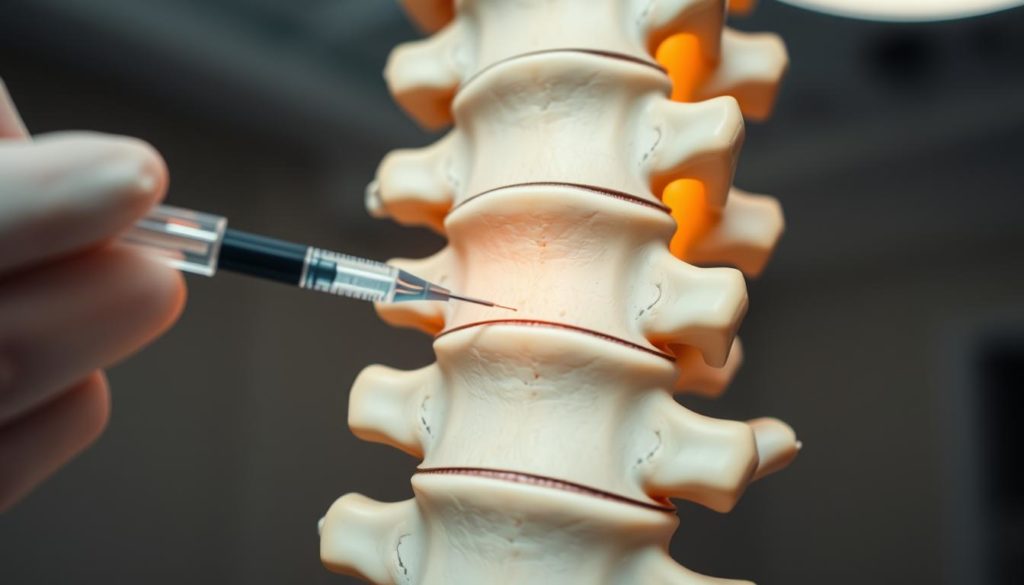Did you know 80% of adults in the U.S. face back pain at some point? This fact highlights the need for strong pain relief methods. Injections for back pain serve as a key solution, particularly when usual treatments fail to ease the discomfort.
There are many spinal injections aimed at reducing pain. They include epidural steroid injections and nerve block treatments. These methods range from providing temporary to long-term relief. Interested? Let’s dive into the different options available for easing back pain.
If you’re dealing with ongoing back issues, understanding the range of injections is key. We’re about to investigate these advanced treatments that could significantly enhance your life.
Understanding Epidural Steroid Injections for Back Pain
Epidural steroid injections (ESI) provide significant relief for those with chronic back pain. This procedure injects powerful steroids right into the epidural space. It targets inflammation in the spinal cord very effectively.

What Is an Epidural Steroid Injection (ESI)?
ESI means putting anti-inflammatory meds around the spinal cord. Its main aim is to cut down inflammation and ease nerve pressure. This greatly reduces pain that spreads from the spine to other areas, like the hips and legs.
Procedure: What to Expect
The ESI process happens in a clinic, using an X-ray for guidance. Patients feel little discomfort while getting the corticosteroid shots into the epidural space. The whole thing is quick, letting people get back to normal activities fast.
Who Should Consider ESI?
If other treatments haven’t eased your pain that moves from your spine to your hips or leg, consider ESI. This method can be very helpful. But, it’s important to know it carries risks like nerve root damage, meningitis, and allergies; though these are rare.
- Pain extending from the spine to the hips or leg
- Lack of relief from other treatments
- Minimal discomfort during the procedure
| Benefits | Cautions |
|---|---|
| Reduces spinal cord inflammation | Risks of nerve root damage |
| Alleviates pressure on nerves | Possibility of meningitis |
| Targets pain effectively | Potential allergic reactions |
Exploring Facet Joint Injections for Back Pain Relief
Facet joint injections are becoming popular for back pain, mainly from spinal arthritis or degenerative conditions. They target the spine’s small joints to reduce pain. This approach offers diagnostic and therapeutic benefits.

What Are Facet Joint Injections?
These injections use a local anesthetic and sometimes a steroid into a spinal joint. This method helps reduce pain from arthritis or injuries. The main aim is quick relief and identifying pain’s cause. It helps doctors understand better treatments for spinal problems.
Diagnostic and Therapeutic Uses
The injections have two main uses. Firstly, they diagnose if the facet joint causes the pain. If pain lessens after the injection, the joint is likely the issue. Secondly, injecting steroids reduces inflammation, easing pain for longer. This can lead to treatments like radiofrequency ablation for lasting relief.
| Aspect | Uses |
|---|---|
| Diagnostic | Identify if a specific facet joint is causing pain |
| Therapeutic | Deliver steroids to reduce inflammation and pain |
Injections for Back Pain: Nerve Block Treatments
Nerve block treatments are a great help for those with severe back pain. They target the pain area directly, bringing much-needed relief. People with different painful conditions find these injections helpful.
How Nerve Blocks Work
Nerve block injections deliver an anesthetic to the area around inflamed or damaged nerves. This helps doctors find out why you hurt while also easing the pain. By stopping the pain signals to your brain, you feel better and more comfortable.
Conditions Treated with Nerve Blocks
Many who suffer from back pain get help from nerve block treatments. Conditions like spinal stenosis and radiculopathy are often treated this way. These treatments are key for easing radiculopathy symptoms, as they lessen pain and make moving around easier.
What to Expect During a Nerve Block Injection
When you get a nerve block for back pain, you might not feel the area for a bit. The procedure is usually fast. Some people might feel a bit sore, have a headache, or feel nauseous after, but these feelings don’t last long.
| Condition | Treatment Outcome |
|---|---|
| Spinal Stenosis | Significant immediate pain relief |
| Radiculopathy | Enhanced mobility and reduced pain |
Sacroiliac Joint Injections: Pain Relief for the Lower Back
SI joint injections offer a way to ease chronic lower back pain. This minimal procedure helps find and ease pain in the sacroiliac joints.
What Are SI Joint Injections?
SI joint injections mix a local anesthetic with steroid medicine, injected straight into the sacroiliac joint. This process aims to lessen lower back pain from SI joint problems. The steroid cuts down inflammation, and the anesthetic numbs the area for quick pain relief.
When Are SI Joint Injections Needed?
If physical therapy and medicine don’t ease sacroiliac joint pain, doctors may suggest SI joint injections. These injections offer relief and help confirm if the SI joint is the pain source. They can greatly improve life by cutting down pain and making movement easier.
Risks and Benefits of SI Joint Injections
SI joint injections can significantly ease lower back pain. But, they might bring risks like infection or, rarely, nerve damage. Often, the chance to reduce pain and better mobility makes these risks worth it.
| Aspect | Benefits | Risks |
|---|---|---|
| Immediate Relief | Reduction in pain and inflammation | Temporary increased pain |
| Diagnosis | Confirmation of SI joint pain source | Infection risk |
| Long-Term Management | Improved mobility and quality of life | Nerve damage (rare) |
Cortisone Injections for Back Pain: What You Need to Know
Cortisone injections are a common way to treat back pain. They help when other treatments don’t work. By injecting corticosteroids into the area, they reduce inflammation and pain.
Cortisone shots can be a good choice for back pain relief. But it’s important to remember that their effects might not last. There are also risks like tissue damage and infection.
Here’s a comparative look at potential benefits and risks:
| Benefits | Risks |
|---|---|
| Quick pain relief | Tissue damage |
| Reduced inflammation | Possible infection |
| Localized treatment | Temporary effect |
Cortisone shots play a big role in treating back pain. They’re helpful when other ways don’t help. Always talk to your doctor to see if it’s right for you.
Understanding the Role of Provocation Discography in Diagnosing Back Pain
Provocation discography is key for spotting spinal issues by figuring out which discs trigger chronic back pain. It’s very helpful for people who haven’t got better with other treatments.
What Is Provocation Discography?
Also called a discogram, this method involves injecting dye into a spinal disc. The pressure on the disc reveals which one is causing pain. It’s vital for identifying spinal issues and planning for surgery.
When Is Provocation Discography Used?
This technique is mainly used when MRIs or CT scans don’t give clear results. It’s for those with ongoing, unexplained back pain. A discogram can show which discs are causing trouble and help plan for surgery.
| Procedure | Purpose |
|---|---|
| Injection of dye into intervertebral disc | Diagnosing spinal conditions |
| Observation of pain response | Identifying problematic discs |
| Planning surgical interventions | Targeting source of chronic back pain |
Implementing Trigger Point Injections for Chronic Back Pain
Trigger point injections help ease chronic back pain. They are great for treating myofascial pain syndrome. These injections focus on painful muscle spots with trigger points or knots. Muscles form these knots when they can’t relax. Getting these injections can bring big relief from ongoing muscle pain.
There are two kinds of trigger point injections. One uses a corticosteroid to lessen inflammation. The other, called dry needling, uses a needle with no medicine. Both help stop pain and make muscles relax. This can bring fast relief.
People with conditions like fibromyalgia and myofascial pain syndrome often get better with these injections. It makes them a top pick for treating chronic back pain. Most times, doctors don’t need X-ray guidance to do the treatment. This makes the process simpler.
| Method | Approach | Benefits |
|---|---|---|
| With Corticosteroid | Injects medication to reduce inflammation | Relieves inflammation, reduces pain |
| Dry Needling | Uses a needle without medication | Breaks pain cycle, promotes muscle relaxation |
These methods are often used to treat myofascial pain syndrome. They give patients a good way to control chronic back pain. The ease and success of trigger point injections make them essential for health care professionals.
Potential Risks and Side Effects of Back Pain Injections
Back pain injections can offer relief but have risks and side effects. Patients should know these before choosing such treatments.
Common Side Effects
After treatment, many patients have injection side effects. These include:
- Soreness at the injection site
- Headaches
- Nausea
For instance, lumbar epidural steroid injections for chronic pain may cause complications.
Serious Risks to Consider
Back pain injection risks might be rare. They can include:
- Bleeding
- Infection
- Nerve damage
- Allergic reactions
Although rare, these risks show why talking with doctors is vital. Knowing about steroid injection complications lets patients consider pros and cons.
| Side Effect | Description |
|---|---|
| Soreness | Mild pain or discomfort at the injection site. |
| Headaches | Head pain occasionally felt after the procedure. |
| Nausea | Feeling of sickness, often occurring post-injection. |
| Bleeding | Uncommon, but can occur at the puncture site. |
| Infection | Rare, involves the development of an infection at the site. |
| Nerve Damage | Potential but rare damage to spinal nerves. |
| Allergic Reactions | Rare responses to medications used in the injection. |
Knowing common and serious side effects helps patients decide on their back pain treatments.
Effectiveness and Long-term Outcomes of Injections for Back Pain
Spinal injections can vary a lot in how well they work for back pain. For some people, they bring long-lasting relief. This improves life quality and lowers the need for ongoing medicine. But for others, the relief is only temporary. They may need more treatments or injections again.
The kind of injection matters a lot. Epidural steroid injections can give extended relief to those with nerve inflammation. Facet joint injections might be better for arthritis-related pain. It’s key to know the pain’s cause to choose the best injection.
Different factors can affect how long relief lasts. Age, health, and other medical issues play a role in treatment success. It’s important to have realistic hopes. See these injections as just one part of managing pain. This should also include physical therapy, lifestyle changes, and other methods to get the best results from back pain injections.
FAQ
What are injections for back pain used for?
Injections help manage back pain when other treatments fail. They offer relief that can be temporary or last longer, depending on the situation.
What is an epidural steroid injection (ESI)?
An ESI is a low-risk procedure. It involves putting medicine into the epidural space to lessen swelling and nerve pressure. This is especially useful when pain spreads to hips or legs.
How do facet joint injections work?
Facet joint injections use a local anesthetic and sometimes a steroid. They treat small spine joints. This helps find the pain source and reduce discomfort.
What conditions can nerve block injections treat?
Nerve block injections are for conditions like spinal stenosis and radiculopathy. They give quick pain relief and help find the pain’s origin by using an anesthetic near affected nerves.
What are sacroiliac (SI) joint injections?
SI joint injections address pain in the lower back, buttock, or leg. This pain comes from SI joint issues. A steroid injection here can ease the pain for a longer time.
What should I know about cortisone injections for back pain?
Cortisone injections reduce inflammation and ease pain by injecting a corticosteroid. They’re for chronic back pain when other approaches don’t work.
What is provocation discography?
Provocation discography tests chronic back pain sources by injecting a special liquid into spine discs. It’s used to decide if surgery is needed.
How do trigger point injections help with chronic back pain?
These injections target muscle knots causing pain. They use a corticosteroid or dry needling. It’s helpful for conditions like fibromyalgia and myofascial pain syndrome.
What are common side effects of back pain injections?
After an injection, you might feel sore, get headaches, or feel nauseous. Serious risks like bleeding, infection, nerve damage, or allergies are rare but can occur.
How effective are back pain injections in the long term?
The success and duration of relief from back pain injections vary. Some find long-term relief, but others might only see short-term benefits. Results depend on the injection type, pain cause, and individual factors.


